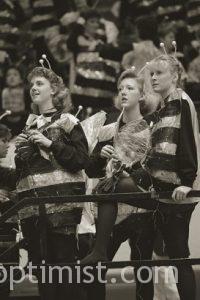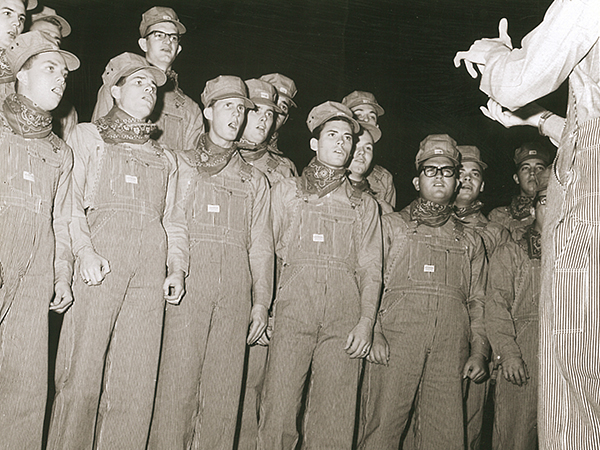When Sing Song began in 1956, the clothing choices started simple. Students wore the same color slacks or skirts and shirts or blouses.
“They dressed more like what you would expect from a choir,” said Tom Craig, director of student productions.
Throughout Sing Song’s six decades, costume designs have changed and evolved, and today, how students look onstage is just as important as how they sound.

Phi Delta Psi performs in 1965.
In the 60s, small elements were added to clothing to go with themes. With a western theme, for example, they wore bandannas or cowboy hats.
“From that,” Craig said, “it progressed to costumes just gradually getting a little more elaborate year after year after year.”
In fact, after Sing Song moved to Moody Coliseum in 1968, students crafted costumes with more creativity. It evolved into participants asking “What can we do bigger and better from the year before?”
The 1970s introduced figural costumes into the performance. Foam material was introduced to craft three-dimensional outfits.
Sewing was a dominant way to make clothing until glue guns were put to use in the 1980s.
Tom Craig recollected one particular act’s costume design choice in 1987: Adam and Eve.

The Adam and Eve act was performed in 1986.
“Adam and Eve were dressed in bodysuits that had leaves applied to them,” Craig said. “The guys, Adam, had a big band-aid on the side where the rib was taken to make Eve. And it was the first time I had seen character costumes come to life in that way.”

Kojies as broadway bumblebees with integrated Christmas lights in 1987.
Broadway Bumblebees in 1986 was another act whose costumes stood out. They were the first Sing Song act to integrate electric lights into their costumes. But improvements did not stop there. Craig said when colored duct tape was introduced in the 90s, students used it to their creative advantage.
The 90s and 2000s also gave affordability to make custom t-shirts, Craig said. Students still use them to this day as base layers for their costumes. Additionally, foam insulation boards started being used more as they were cheap, light-weight and able to take paint well with the plastic coating taken off.
Despite how far costume designs have come, they also share a commonality.
“The common denominator among all of our Sing Song costumes is the creative factor,” Craig said. All costumes help enhance stories and add to stage performances, but creativity is what stands out the most.
“And when you think back from then all the up way to now,” Craig said, “it really is the creativity that makes it come to life.”

The 2011 sophomore class put their hearts into their act.

